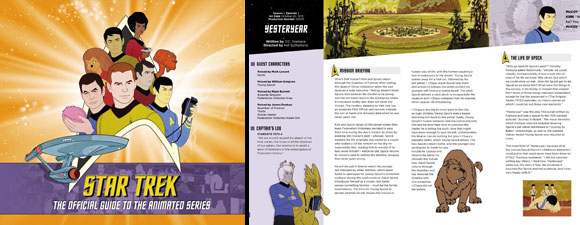Retro Review: The Counter-Clock Incident
6 min readWhen the Enterprise’s first captain travels aboard the ship to his retirement ceremony, the crew is pulled into a universe where time works backwards and everyone grows younger.
Plot Summary: Commodore Robert April, first captain of the Enterprise, is being taken in his onetime ship to his retirement ceremony along with his wife Sarah April, the ship’s first chief medical officer. Neither is happy about Starfleet’s mandatory retirement age of 75. An alien ship appears on scans traveling at the incredible speed of warp 36 directly at the Beta Niobe nova. Unable to communicate with the pilot because she seems to be speaking backward, Kirk orders the ship held in the Enterprise’s tractor beam to stop it from destroying itself, but the beam tows the Enterprise into the nova along with the alien vessel. Both ships emerge in an alternate universe where space is white, the stars are black, and time runs in reverse. The captain of the alien ship introduces herself in now-reversed English as Karla Five and says she had to fly into the nova to return to her own universe, a journey endangered by the Enterprise with its tractor. Because the Enterprise is now trapped, Karla leads it to Arret, where she and her son Karl – who is older than she is – theorize that if they can trigger a nova in their universe at the parallel spot to a nova in Kirk’s universe, then the Enterprise will be able to return home by reversing the process that brought it to Karla’s universe. She sacrifices her ship to aid their return, but the Enterprise crew is aging in reverse; first Sulu, then Uhura, then others lose the ability to control their instruments. Soon only the Aprils and a teenage Spock are capable of taking the Enterprise through the nova. The Aprils use the transporter to restore everyone to correct ages and Sarah considers remaining young, but Robert persuades her that their lives have been satisfying already. En route to the retirement ceremony once more, the Aprils learn that because of their heroism, Starfleet is reviewing its mandatory retirement policy and they may be allowed to continue to serve.
Analysis: Star Trek: The Animated Series ends on a high note with “The Counter-Clock Incident”; though the science is ludicrous, it’s not particularly out of sync with the chronometers running backward in “The Naked Time” and it’s an increasingly rare example in science fiction of age and experience trumping youth and strength. The notion that Starfleet ever had a mandatory retirement at age 75 now seems hopelessly antiquated – how old was McCoy supposed to be when he appeared on the Enterprise-D at the start of Star Trek: The Next Generation? William Shatner is over 75 and hasn’t slowed down a bit, and I don’t doubt that if Kirk had lived (or returned from the dead), he’d have insisted on working as well. The Aprils are a delightful couple and I’m only sorry they didn’t turn up earlier in the franchise so we could see more of them. I love working couples, and from what we hear after the fact, these two had a very long personal and professional collaboration; I wish we could have seen it in action, rather than at the end when his more glorified position as captain is about to be taken away from him and he’s giving her little orders when he can.
“The Counter-Clock Incident” is one of few episodes with a sustained metaphor underlining the theme, in this case a Capellan flower that has a life cycle of only a few hours. When she’s first complimented on its beauty, Sarah regretfully explains that the bloom is already dying, but when the ship enters the parallel universe where time runs backward, it ceases to wilt and becomes a bright blossom before it begins to devolve into a seed. Robert and Sarah (voiced somewhat obviously by James Doohan and Nichelle Nichols) hardly seem to be wilting – neither is infirm and both are mentally acute, if unhappy at the phase of their lives which is ending – but like the flower they return to their prime in the alternate universe, with Robert very much resembling Kirk. It doesn’t make any scientific sense that gray hair would abruptly turn brown and aging skin would instantly slough off to reveal smoother young skin, though that’s easier to swallow than the idea that one’s descendants can be born before oneself and one’s ancestors after oneself – how does that process of birth work, exactly? Will Karla 5’s father become a fetus as he de-ages, and where will he gestate? Then there’s the concept of black stars in white space, where it’s never explained whether the change is to the nature of space and energy or to human retinas and how those are perceived. The physics and metaphysics receive very little attention, and in fact, to my recollection, Alan Dean Foster rewrote them entirely in the novelization of the episode for the Star Trek Logs series because it turned out that the negative universe was a fake.
But the science isn’t what’s important here. We end the animated series with a glimpse into early Star Trek history (in a real-world sense as well as fictional, because April was Gene Roddenberry’s original name for the captain in “The Cage”). It’s evident that Kirk and his crew are familiar with the Aprils and their accomplishments; McCoy even reveals that Sarah designed a lot of the instruments now standard in sickbay. April’s retirement ceremony is due to take place on Babel, the planet we already know to be a center for Federation diplomatic activity, and April is aware that Kirk was present when Beta Niobe began to supernova, just as Kirk is aware that April was present when the Enterprise was being built. To add to the sense of nostalgia, we get to see animated representations of the crewmembers as teenagers and children, including a Spock who’s beginning to look like the boy from “Yesteryear” when the ship travels back to its own universe. It’s a boon of animation that so many characters can be shown de-aging. Thematically, this development is a lot like the Next Generation finale “All Good Things” in which Picard, leaping through eras of his own life, must come to terms with his mortality and at the same time solve a major scientific problem.
It’s a bit sad that in this last animated episode (and last original series installment before the films), the focus is not on the regular characters, yet it’s very much in the spirit of Star Trek to display the sort of continuity that looks back at a previous crew and gives them one more chance to excel. Given the choice to remain a young man and continue his remarkable career, Robert April declines, feeling that since he has no regrets, he doesn’t want to risk the happy memories of the career and life he has already shared with Sarah. This isn’t a man who’d be happy with illusion or remain in the Nexus…a worthy predecessor to Pike, Kirk, and Picard. And if his wife has a moment of wavering, one gets the impression it’s because even in her century she’s been regarded too long in her husband’s shadow; her own successor, McCoy, isn’t aware of all her contributions until she arrives on the ship. This universe and its parallel are places where families work together, leaders risk their lives to save strangers, scientists sacrifice their ships to help others, and officers readily give up command for the good of others. “The Counter-Clock Incident” encapsulates much that is good about Star Trek – not just the animated series but the entire franchise.







And that’s one more series down. Congrats, MEG!
Speaking of Robert April, there is a nice lot of collected appearances of the elusive first captain (in novels and comic books) here. An easy way to learn the character’s history:
http://www.ebay.com/itm/130675470121?ssPageName=STRK:MESELX:IT&_trksid=p3984.m1555.l2649#ht_500wt_1413